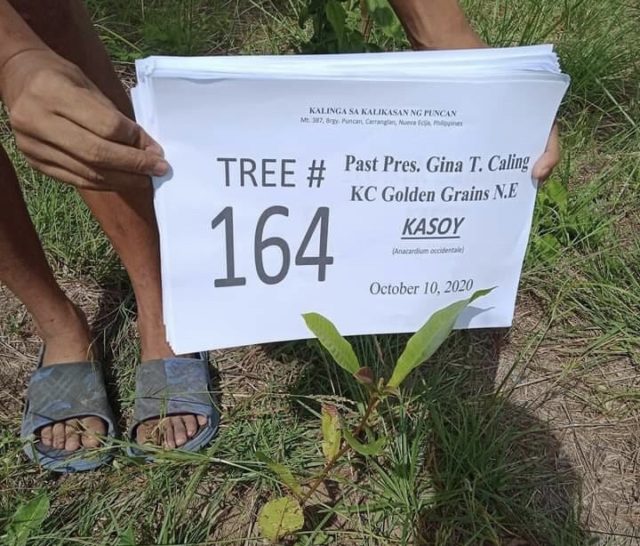A tree seedling planted at Mt. 387 bearing the name of its sponsor. Contributed photo
CARRANGLAN, Nueva Ecija – A different type of “plantitos” and “plantitas” has ascended Mt. 387 here.
Mountain “ninongs” and “ninangs” they are called because they shell out cash for the mountain’s nourishment and youth education, instead of gathering exotic plants to bring down to the lowlands for trade or home ornaments.
Groups and individuals donate P200 for each seedling which students who serve as tourist guides plant within the so-called “Banaba, Kasoy at Duhat Tree Parks” at the 761-meter summit of the mountain in Barangay Puncan here.
The students, mostly from indigenous communities, were the recipients of the program “Laban sa Pandemya: Sagip Hanapbuhay, Sagip Mt. 387,” according to Roy Manuzon, head of Kalinga sa Kalikasan ng Puncan (Kapuncan).
“Pinayagan lang namin silang mag-guide para makatulong sa pag-aaral nila,” Manuzon explained. “Then, sila din ang pangunahing inuupahan na magtanim ng puno para sa project para makaipon sila ng pambili ng gadgets at iba pang school needs. Wala kasing masyadong turista ngayon,” he added.
Gadgets like internet-capable mobile phones, tablets or laptops are essential requirement for students to be able to join online classes amid the battle against coronavirus disease pandemic.
“Plantitos” and “plantitas” refer to people who venture into planting mostly decorative or ornamental plants or shrubs to cope with the stress and while away time during the lockdown.
The trees are being named after the sponsors. “Ang commitment namin ay sisuguruhin namin na maalagaan at mabubuhay ang mga puno,” Manuzon said. About 650 trees have been planted since the program started this July.
“Masarap suportahan ang programa dahil malaking tulong sa reforestation at sa kinabukasan ng mga bata,” said radio broadcaster Juaneth Bondad, a member of Philippine Luzon District, Dvision 2C-2 of Kiwanis International.
The organization sponsored 37 trees and separately planted 270 coffee trees.
Mt. 387 which name stands for its total area of 387.9 hectares became one of the most visited places in Nueva Ecija by local tourists and mountaineers before the pandemic. Its summit can be reached in two hours on the average.
Kapuncan takes care of the area under the Adopt a Mountain Program of the Department of Environment and Natural Resources.
Getting to Mt. 387 actually is also taking a journey through world history.
“Isa sa mga major defenses ng Japanese Army ang summit nito during World War II,” said Manuzon.
“The summit is called Batong Amat, or ghost rock. ‘Amat’ in adjacent Pantabangan town means ghosts,” he explained. “At Batong Amat, one can enjoy the panoramic view of Nueva Ecija and portions of Pantabangan.”
Just 125 meters below the summit is a pine tree which a Nueva Ecija mountaineers group call “Lovers’ Tree,” and a campsite for stargazing as well as a vantage point from where to ponder city lights.
From there, Manuzon said, mountaineers take the challenge of taking an over–45– degree slope traverse trail going to the popular Aloha Falls, another beauty that nature has to offer.
“Napakasarap maligo sa Aloha Falls. Para siyang Sto Niño Cold Spring ng Camiguin,” he said.
Mt. 387 also traverses part of Talavera Watershed Forest Reserve within the Caraballo Mountain range.
A dump truck ride going back to the jump off site serves as a closing remark for the most memorable date with Mother Earth.





